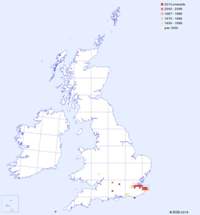The Lady Orchid is classified as Nationally Scarce and listed as Endangered. It maintains a stronghold in Kent, although a few isolated plants and small colonies have become established in other southern counties, notably in Oxfordshire. As its common name implies, the Lady Orchid is one of four British orchids with an anthropomorphic flower. Orchis purpurea favours woodland sites and normally flowers from early May through to early June. The Lady Orchid is still widespread in many European countries.
| Distribution Map | Key Features | |
 |
Records for the Lady Orchid from BSBI are shown on the map with most recent in front. (Hover the mouse over the small map to expand it.) |
Plant: 20-50cm but can reach 90cm. |
Image Gallery for Lady Orchid Orchis purpurea
| Pollination | Taxonomy & Hybrids |
Lady Orchid is pollinated by various small bees and flies, but subsequent growth from seed is unreliable. Vegetative reproduction is also known to produce clumps of plants. |
The range of the Lady Orchid in the UK is now centred around Kent and two very rare hybrids have been reported from the county. Ophrys x wilmsii is a hybrid with Early Purple Orchid Orchis mascula, and Ophrys x meilsheimeri is a hybrid with Man Orchid Orchis anthropophora. In Oxfordshire there is a well known site with hybrids between Lady Orchid and Monkey Orchid Orchis simia, often referred to as Lankey Orchids. |
Articles about Lady Orchid in JHOS
David Johnson (2012 ) Herbivore Pressure on Orchid Populations – Nippers Re-visited. JHOS 9: 14-15
Mike Gasson (2012) Lost Ladies – Does It Matter? JHOS 9: 15-17
Alfred Gay (2013) Further Notes on Orchis purpurea Herbivory and Conservation. JHOS 10: 12-13
